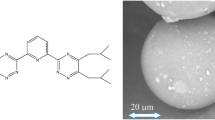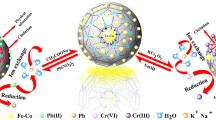Abstract
The difficulty of removing low-concentration heavy metals from wastewater and the impact of coexisting anions on adsorption and regeneration performance has been widely recognized. To address this challenge, we synthesized a new adsorbent called porous boron nitride (PBN) and characterized it with X-ray diffraction, scanning electron microscopy, Fourier transform infrared spectroscopy, and nitrogen isothermal adsorption–desorption isotherms. Then, the adsorption kinetics and equilibrium models of PBN for Cd(II) and Ni(II) with a concentration as low as 10 mg/L, along with the impact of anions on adsorption performance and the regeneration of PBN, were investigated. The findings indicated that PBN achieved adsorption equilibrium for Cd(II) and Ni(II) in just 5 min. Furthermore, the adsorption processes fit better with the pseudo-second order kinetic model and the Freundlich isothermal model. Especially, we found that the presence of SO42− inhibited the adsorption of Cd(II) and Ni(II), whereas SiO32−, CO32−, and PO43− promoted adsorption by forming a PBN-anion-metal ternary complex. We determined that the adsorption mechanism involved electrostatic attraction and chemisorption. After regeneration, PBN retained its crystal structure and typical pore distribution, demonstrating excellent adsorption performance for heavy metals.








Similar content being viewed by others
Data availability
Data will be available on request.
References
Bai XS, Lin JW, Zhang ZB, Zhan YH (2022) Immobilization of lead, copper, cadmium, nickel, and zinc in sediment by red mud: adsorption characteristics, mechanism, and effect of dosage on immobilization efficiency. Environ Sci Pollut Res 29:51793–51814
Buema G, Lupu N, Chiriac H, Ciobanu G, Bucur RD, Bucur D, Favier L et al (2021a) Performance assessment of five adsorbents based on fly ash for removal of cadmium ions. J Mol Liq 333:15–15
Buema G, Borhan AI, Herea DD, Stoian G, Chiriac H, Lupu N, Roman T et al (2021b) Magnetic solid-phase extraction of cadmium ions by hybrid self-assembled multicore type nanobeads. Polymers 13:15–15
Calderón OAR, Abdeldayem OM, Pugazhendhi A, Rene ER (2020) Current updates and perspectives of biosorption technology: an alternative for the removal of heavy metals from wastewater. Curr Pollut Rep 6:8–27
Celebi H, Gok G, Gok O (2020) Adsorption capability of brewed tea waste in waters containing toxic lead(II), cadmium (II), nickel (II), and zinc(II) heavy metal ions. Sci Rep 10:17570
Chen G, Shah KJ, Shi L, Chiang PC (2017) Removal of Cd(II) and Pb(II) ions from aqueous solutions by synthetic mineral adsorbent: Performance and mechanisms. Appl Surf Sci 409:296–305
Egbosiuba TC, Egwunyenga MC, Tijani JO, Mustapha S, Abdulkareem AS, Kovo AS, Krikstolaityte V et al (2022) Activated multi-walled carbon nanotubes decorated with zero valent nickel nanoparticles for arsenic, cadmium and lead adsorption from wastewater in a batch and continuous flow modes. J Hazard Mater 423:126993
Feng XF, Long RX, Wang LL, Liu CC, Bai ZX, Liu XB (2022) A review on heavy metal ions adsorption from water by layered double hydroxide and its composites. Sep Purif Technol 284:120099
Freundlich H (1907) Uber die adsorption in losungen. J Phys Chem 57:385
He J, Li Y, Wang C, Zhang K, Liu J (2017) Rapid adsorption of Pb, Cu and Cd from aqueous solutions by β-cyclodextrin polymers. Appl Surf Sci 426:29–39
Hwang SY, Lee GB, Kim JH, Hong BU, Park JE (2020) Pre-treatment methods for regeneration of spent activated carbon. Molecules 25:4561
Khanam R, Kumar A, Nayak AK, Shahid M, Tripathi R, Vijayakumar S, Bhaduri D et al (2020) Metal(loid)s (As, Hg, Se, Pb and Cd) in paddy soil: bioavailability and potential risk to human health. Sci Total Environ 699:134330
Kong J, Gu R, Yuan J, Liu W, Wu J, Fei Z (2018) Adsorption behavior of Ni(II) onto activated carbons from hide waste and high-pressure steaming hide waste. Ecotox Environ Safe 156:294–300
Kumar A, Song HW, Mishra S, Zhang W, Zhang YL, Zhang QR, Yu ZG (2023) Application of microbial-induced carbonate precipitation (MICP) techniques to remove heavy metal in the natural environment: a critical review. Chemosphere 318:137894
Kumar R, Sharma RK, Singh AP (2019) Sorption of Ni (II), Pb (II) and Cu (II) ions from aqueous solutions by cellulose grafted with poly (HEMA-co-AAc): kinetic, isotherm and thermodynamic study. J Environ Chem Eng 7(3):103088
Langmuir I (1918) The adsorption of gases on plane surfaces of glass, mica and platinum. J Am Chem Soc 40(9):1361–1403
Lee SY, Choi HJ (2018) Persimmon leaf bio-waste for adsorptive removal of heavy metals from aqueous solution. J Environ Manage 209:382–392
Lekgoba T, Ntuli F, Falayi T (2021) Application of coal fly ash for treatment of wastewater containing a binary mixture of copper and nickel. J Water Process Eng 40:12–12
Li J, Lin J, Xu X, Zhang X, Xue Y, Mi J (2013a) Porous boron nitride with a high surface area: hydrogen storage and water treatment. Nanotechnology 24(15):155603
Li J, **ao X, Xu X, Lin J, Huang Y, Xue Y, ** P, Zou J, Tang C (2013b) Activated boron nitride as an effective adsorbent for metal ions and organic pollutants. Sci Rep 3:3208
Lin J, Su B, Sun M, Chen B, Chen Z (2018) Biosynthesized iron oxide nanoparticles used for optimized removal of cadmium with response surface methodology. Sci Total Environ 627:314–321
Liu T, Li Y, He J, Zhang K, Yi Hu, Chen X (2019a) Few-layered boron nitride nanosheets as superior adsorbents for the rapid removal of lead ions from water. J Mater Sci 54(7):5366–5380
Liu T, Li Y, He J (2019b) Porous boron nitride nanoribbons with large width as superior adsorbents for the rapid removal of cadmium and copper ions from water. New J Chem 43(8):3280–3290
Madawala CK, Jahinge THL, Rathnayake KT, Perera BA (2023) Adsorption of cadmium (II) from aqueous solutions by coconut dregs residue: kinetic and thermodynamic studies. Sep Sci Technol 58:1972–1984
Mcbride MB (1994) Environmental chemistry of soils. Oxford University Press, Oxford, pp 4–7
Tempkin MI, Pyzhev V (1940) Kinetics of ammonia synthesis on promoted iron catalyst. Acta Physiochim URSS 12:327–356
Qasem NAA, Mohammed RH, Lawal DU (2021) Removal of heavy metal ions from wastewater: a comprehensive and critical review. NPJ Clean Water 4:36
Qiu M, He C (2019) Efficient removal of heavy metal ions by forward osmosis membrane with a polydopamine modified zeolitic imidazolate framework incorporated selective layer. J Hazard Mater 367:339–347
Reddy TV, Chauhan S, Chakraborty S (2017) Adsorption isotherm and kinetics analysis of hexavalent chromium and mercury on mustard oil cake. Engviron Eng Res 22(1):95–107
Redlich O, Peterson DL (1959) A useful adsorption isotherm. J Phys Chem 63(6):1024–1024
Song Q, Liang J, Fang Y (2020) Nickel(II) modified porous boron nitride: an effective adsorbent for tetracycline removal from aqueous solution. Chem Eng J 394:124985
Sun H, Shi B, Yang F, Wang D (2017) Effects of sulfate on heavy metal release from iron corrosion scales in drinking water distribution system. Water Res 114:69–77
Tan Y, Yin X, Wang C, Sun H, Ma A, Zhang G, Wang N (2019) Sorption of cadmium onto Mg-Fe Layered Double Hydroxide (LDH)-Kiwi branch biochar. Env Pollut Bioavail 31:189–197
Thommes M, Kaneko K, Neimark A, Olivier J, Rodriguez-Reinoso F, Rouquerol J, Sing K (2015) Physisorption of gases, with special reference to the evaluation of surface area and pore size distribution (IUPAC Technical Report). Pure Appl Chem 87:1051–1069
Tiberg C, Sjöstedt C, Persson I, Gustafsson JP (2013) Phosphate effects on copper(II) and lead(II) sorption to ferrihydrite. Geochim Cosmochim Acta 120:140–157
Velarde L, Nabavi MS, Escalera E, Antti ML, Akhtar F (2023) Adsorption of heavy metals on natural zeolites: a review. Chemosphere 328:138508
Wang H, Wang W, Wang H, Zhang F, Fu Z (2018) Urchin-like boron nitride hierarchical structure assembled by nanotubes-nanosheets for effective removal of heavy metal ions. Ceram Int 44:12216–12224
Wang M, Bai Y, Zhang B, Zhong B, Yu Y, Zhang J, Huang X, Wen G (2019) Large scale fabrication of porous boron nitride microrods with tunable pore size for superior copper (II) ion adsorption. Ceram Int 45:6684–6692
Wang W, Zhou J, Achari G, Yu J, Cai W (2014a) Cr(VI) removal from aqueous solutions by hydrothermal synthetic layered double hydroxides: Adsorption performance, coexisting anions and regeneration studies. Colloid Surf A-Physicochem Eng Asp 457:33–40
Wang Y, Wang S, Sun H, Lei J, Ye T, Lin L, Wang L (2014b) Crayfish carapace powder adsorbing heavy metal ions from aqueous solution: capacity, characterization, mechanism. J Aquat Food Prod Technol 25:122–130
**ang J, Lin Q, Cheng S, Guo J, Yao X, Liu Q, Yin G et al (2018) Enhanced adsorption of Cd(II) from aqueous solution by a magnesium oxide-rice husk biochar composite. Environ Sci Pollut Res 25:14032–14042
Xu C, Zeng J, Gu X, Wang Y, Li E, Zhang C, Ge C et al (2022) Porous monolith of few-layered boron nitride for effective water cleanup. J Mater Chem A 10:846–854
Xue L, Lu B, Wu Z, Ge C, Wang P (2014) Synthesis of mesoporous hexagonal boron nitride fibers with high surface area for efficient removal of organic pollutants. Chem Eng J 243:494–499
Yang GX, Jiang H (2014) Amino modification of biochar for enhanced adsorption of copper ions from synthetic wastewater. Water Res 48:396–405
Yaqub M, Lee SH (2019) Heavy metals removal from aqueous solution through micellar enhanced ultrafiltration: A review. Environ Eng Res 24:363–375
Zamora-Ledezma C, Negrete-Bolagay D, Figueroa F, Zamora-Ledezma E, Ni M, Alexis F, Guerrero VH (2021) Heavy metal water pollution: a fresh look about hazards, novel and conventional remediation methods. Environ Technol Innovation 22:101504
Zhou G, Luo J, Liu C, Chu L, Crittenden J (2018) Efficient heavy metal removal from industrial melting effluent using fixed-bed process based on porous hydrogel adsorbents. Water Res 131:246–254
Zinicovscaia I, Yushin N, Grozdov D, Vergel K, Popova N, Artemiev G, Safonov A (2020) Metal removal from nickel-containing effluents using mineral-organic hybrid adsorbent. Materials 13:21–21
Zou C, Jiang W, Liang J, Guan Y, Sun X (2019) Desorption regeneration performance of magnetic bentonite after Pb(II) adsorbed. ChemistrySelect 4:1306–1315
Acknowledgements
This work was supported by the Key Technology Research and Development Program of China (Award Number: 2021YFC3201405), and the National Natural Science Foundation of China (Award Number: 51608165).
Author information
Authors and Affiliations
Corresponding author
Ethics declarations
Competing interest
The authors declare that they have no known competing financial interests or personal relationships that could have appeared to influence the work reported in this paper.
Additional information
Publisher's Note
Springer Nature remains neutral with regard to jurisdictional claims in published maps and institutional affiliations.
Rights and permissions
Springer Nature or its licensor (e.g. a society or other partner) holds exclusive rights to this article under a publishing agreement with the author(s) or other rightsholder(s); author self-archiving of the accepted manuscript version of this article is solely governed by the terms of such publishing agreement and applicable law.
About this article
Cite this article
Han, F., Zhao, M. & Ding, X. A novel study on the adsorption of low concentration Cd(II) and Ni(II) using porous boron nitride: effectiveness, coexisting anion interference, and regeneration. Braz. J. Chem. Eng. (2024). https://doi.org/10.1007/s43153-024-00451-1
Received:
Revised:
Accepted:
Published:
DOI: https://doi.org/10.1007/s43153-024-00451-1




